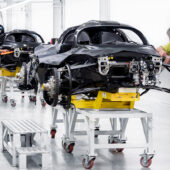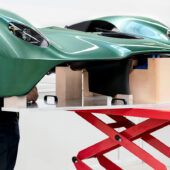The Aston Martin Valkyrie is the most extreme road car ever produced by the firm, with one eye fixed on Hypercar-class racing
Words: Jon Burgess
An Aston senior manager in the 1980s simply wouldn’t recognise the Valkyrie as it stood on the road; a car that offered performance far in excess of the Aston Martin Nimrod that could also be driven on the road would be impossible to comprehend.
Yet today, at the very top of the market, sophisticated hybrid hypercars dominate – the Mercedes-AMG One, McLaren Speedtail, Czinger 21C and Koenigsegg Regera, among others – each bringing true racing car performance to the road, at least for those with a few million to spend on their next car.
Aston wanted to attract those buyers – and had the means and engineering talent to do so, thanks to a partnership with Red Bull Racing. Its chief technical officer, Adrian Newey, wanted to build an ‘F1 car for the road’ since he was six years old; with then CEO Dr Andy Palmer, Red Bull Racing principal Christian Horner and head of Aston Martin Marketing and PR Simon Sproule on board, it was decided early in development to chase the title for fastest street-legal car in the world.
At least 1000bhp was required and the car that resulted needed to be capable of driving on the public roads as well as a track. Codenamed Nebula, a portmanteau-acronym of [Adrian] Newey, Red Bull and Aston Martin, the AM-RB 001 concept that resulted was eventually named Valkyrie.

The name, given to a powerful Norse folklore figure, also played into the ‘V’ designation for Aston Martin’s fastest cars, tiered by performance by category. Apart from the historic ‘Vantage’ nameplate, which began with the DB2, Vanquish, Vulcan and Victor also featured on fast and increasingly exclusive Astons, the latter two ‘V-bombers’ apropos the Valkyrie, were track cars that could not be driven on the road.
Cosworth, another partner, rose to the challenge when it, together with Red Bull Racing, was tasked with producing the Valkyrie’s engine. Dubbed the ‘RA’, the 6.5-litre unit was a stressed member of the chassis tub, used titanium conrods and had a rev limit of 11,100 rpm, with peak power of 1000bhp arriving at 10,500rpm. Owing to F1 production techniques, the RA’s crankshaft weighed less when completed than that of the One-77’s 7.3-litre V12; briefly the world’s most powerful N/A engine.
Assisted by a Formula 1-derived (and Powertrain/Rimac-developed) kinetic energy recovery system (KERS), the hybrid drivetrain consisted of a gearbox mounted electric motor and battery pack and added a further 160bhp to the Valkyrie’s statistics. This was eventually curtailed to 1139bhp for production cars, although Aston did not disclose the reason for the slight drop in power.
One thing that certainly did for the efficacy of the Valkyrie was its kerbweight: 1030kg, and with peak downforce from underwing and over body airflow of 1816kg at higher speeds producing more than 300kg over the modified Vulcan AMR Pro. Like the Vulcan, its tyres were fast-road Michelin Sport Cup 2s, staggered on 20-inch wheels fore and 21-inch aft.

The public got its first glimpse of a production-ready Valkyrie in 2017 online; a year before, the AM-RB 001 concept had fleshed out the basic shape displayed as a non-running scale model at Aston Martin’s Gaydon headquarters; panels were eventually clothed in carbon fibre. Interest in the car was high, with then-CEO Dr Andy Palmer warning speculators not to put down deposits only to sell cars on again for a profit off the waiting list; he was quoted as warning buyers that they would never again be eligible for any other Aston Martin ‘V-bomber’ special again.
A running development Valkyrie appeared before crowds at the start of the 2019 British Grand Prix at Silverstone; by late 2021, after life had turned back to relative normality, assembly of the first customer-ready Valkyrie began at Gaydon, beset by delays but still meeting the target set by Aston Martin’s then-CEO and CTO Tobias Moers, which each car shaken down at the historic home of the British Grand Prix.
Aston laid down the build status: 150 roadgoing Valkyries were to be built, with a base price of approximately $3million £2.4 million; 40 further track only cars, again sold under the AMR Pro banner, retailed for $3.5 million (£2.8 million) and ditched the hybrid motor and battery pack, leaving the car to run solely on its 6.5-litre V12.
Uprated brakes and 18-inch wheels (to run LMP1 race tyres) take the AMR Pro further away from the road Valkyrie; tweaks to the wheelbase and aerodynamics (extended by 380mm, the chassis track by 96mm at the front and 115mm at the rear) extend the whole car by 260mm. Aston quoted the Valkyrie AMR Pro as being able to generate up to 3G lateral grip in corners, and produce twice the peak downforce at speed compared to the road Valkyrie.
Thinner carbon fibre bodywork, carbon suspension wishbones, and plastic windows further cut the weight of the AMR Pro, with Aston Martin claiming a three-minute 20 lap time around Le Mans 8.5-mile circuit, enough to put it on the grid of an Le Mans Hypercar race. The Valkyrie was set to do just that, but rule changes and a rather important full-factory F1 entry saw Aston’s Hypercar racing plans put on ice in 2020.

Another 85 Valkyries were confirmed to be Roadster models; similar mechanically to the 150 coupe Valkyries, special bodywork was fitted to the Roadster, revealed at the Pebble Beach Concours d’Elegance (part of Monterey Car Week) in California, USA.
There was no loss of rigidity in the tub of the Spider, though the removable roof and windows were now made of polycarbonate with a slight weight penalty for losing the roof section; front hinged scissor doors replace the gullwing-windowed doors of the coupe.
Quoted top speed dropped from 217mph to 205 mph with the roof down; Aston Martin recalibrated the active aerodynamics to work with the new doors and roof arrangement so that the same amount of downforce was generated by the Roadster; equivalent cars from McLaren and Mercedes-AMG did not offer open models. To that end, order books were oversubscribed, and deliveries began in early 2022.
Aston Martin Valkyrie timeline
2015
Codename Nebula begins – a collaboration to build an F1 car for the road between Adrian Newey, Red Bull Racing and Aston Martin. Other specialists such as Multimatic, Powertrain and Rimac are enlisted to develop the carbon fibre tub and suspension, hybrid motor and battery pack
2016
Scale model of the AM-RB 001 is revealed as a static scale model at Aston Martin headquarters
2017
Valkyrie interior and exterior are leaked online
2018
Cosworth confirm specification and details of 6.5-litre ‘RB’ V12, revealing that it will produce 1000bhp. Other details leaked about the Valkyrie include its active aerodynamics, performance figures and KERS-backed hybrid system. Track-only AMR Pro shown as concept car

2019
Development Valkyrie laps Silverstone before that year’s British Grand Prix
2020
Red Bull F1 drivers Max Verstappen and Alexander Albon get behind the wheel of production-ready Valkyrie models

2021
Production gets underway, on target, in November. 150 coupes and 40 AMR Pros to be produced
Valkyrie Roadster, with removable polycarbonate roof, shown off at Pebble Beach in the United States; 85 cars confirmed
2022
Customer deliveries of Roadster begin in March























